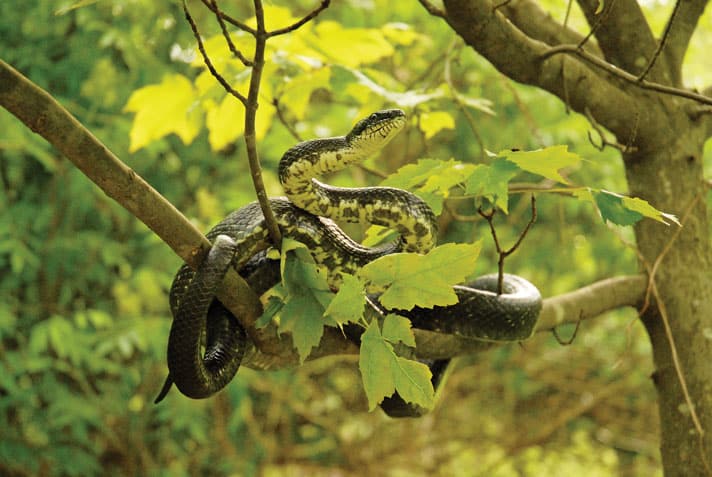Some of the best general areas for field herping in the United States.
Keeping herps has become a hugely popular hobby, largely because it lets hobbyists enjoy a closeness to nature that many find little time to enjoy in their modern lives. Yet for some, it’ll never be a substitute for getting out into nature to observe it wild and woolly.
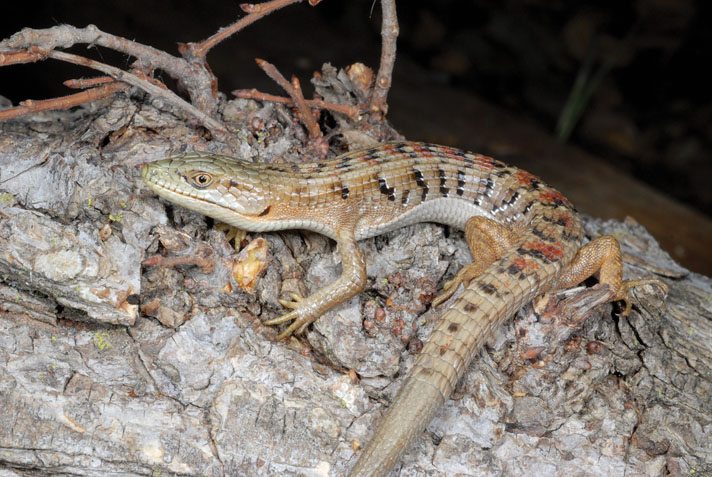
bill love
Alligator lizards of the genus Elgaria can be found in many montane habitats all over the extreme southwestern U.S. If you attempt to catch one, prepare to be nipped.
My youth was spent chasing wild herps, a trend I see slowly becoming less and less of a beginning for the growing legions of enthusiasts today. I’ll always feel that those whose first pets originate in deli cups or cages miss a valuable basic ingredient of the passion that drew them to herps in the first place. Toward that end, this article will reveal some of my favorite places in the U.S. to encounter wild herps for the sheer fun of it.
Before we get to it, I’m compelled to add a footnote: With all the healthy, captive-bred herps available today at cheap prices, there’s little need to catch wild ones for spur-of-the-moment pets. More people today are enjoying the art of remembering their finds via the photos they snap. The thrill of the hunt is still captured, and the joy of knowing that the creatures we encountered are still roaming free is the icing on the cake. And anyone who can afford a decent camera and connection to the internet can share their photos widely like never before. But before you do, there’s four important factors to keep in mind.
Don’t provide too much information. Don’t publish descriptions of your hotspots on social media if you wish to revisit them again someday and see herps there. It’s bad field-herping etiquette to describe exact locales in too much detail.
As exciting as it is to share great spots where you may have seen an abundance of herps with relative ease, trust me, your spot won’t stay so wonderful and pristine if you reveal it to the world. Humanity will all too often make a beeline to your sacred place, scaring away the wildlife, leaving trash, shooting or taking the animals away, and generally ruining it. It’s simply an unavoidable consequence of our overcrowded planet and shrinking natural areas accessible to the public, or existing at all in many cases.
Want To Learn More?
There are no formal guidelines about how precise the information you share should be. My personal ethics on the subject advise never getting more detailed than describing a mountain range or a road. If you narrow it down any further, say to any particular canyon or streambed, or to a special stretch of a highway on which to road-cruise, you’re inviting rapid degradation. Provide some basics, but leave it to those following in your footsteps to discover the particulars for themselves.
Get permission from land owners. Don’t trespass while field herping. Always seek permission to enter private property.
Pull all the way over. With increased tightening up of access to private property, road hunting may actually become a more popular alternative that at least keeps you on public land. The trick is to find less-traveled roads passing through good herp country where traffic won’t squash the animals you hope to see alive. If you see a herp while road cruising and want to stop to observe it, pull completely off the pavement so as not to impede the flow of traffic.
Obtain a license if necessary. Some states (like Arizona) require you to obtain a hunting license even if you’re only seeking herps to look at or photograph, and even outside of parks and reserves. Nothing like discouraging nature tourism, but it’s the way the law is written in certain places, like it or not.
Now, let’s visit the U.S. hotspots that have provided me with my best field-herping memories!
Herping In Florida
Florida’s Everglades is still one of the snakiest places of all! Alligator Alley (State Road 84) traverses the “Glades” between Ft. Lauderdale and Naples. There are numerous places to stop along the way, at waterway crossings where you can get out and stretch your legs.
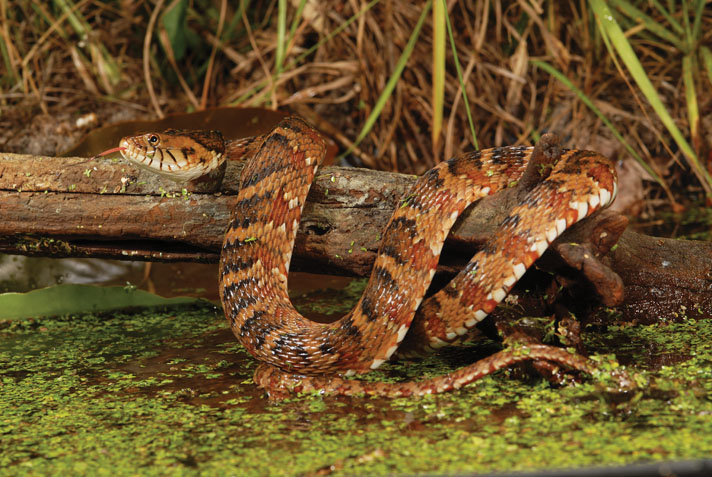
bill love
The appearance of water snakes of the genus Nerodia varies widely where they occur — mostly near water — across the eastern two-thirds of the U.S.
Where possible, get down next to the canals and slowly trudge along, peering into the weeds looking for several kinds of water snakes that are common there. Banded water snakes (Nerodia fasciata) and Florida green water snakes (N. floridana) abound, with brown water snakes (N. taxispilota) a distant third. Most will be near the surface prowling through the greenery seeking frogs and fish, though only portions of their bodies, or maybe just their heads, may be visible. Move quietly and keep a low profile to avoid scaring them into hiding.
Other species, such as garters and ribbon snakes (Thamnophis sirtalis and T. sauritus), mud snakes (Farancia abacura), two swamp snakes, Liodytes pygaea and L. alleni, occasional yellow rat snakes (Pantherophis obsoletus) and rough green snakes (Opheodrys aestivus) may be found in these environs.
A half-dozen aquatic turtle species may also forage in the weed-choked edge zones of Florida canals. But tread cautiously because water moccasins (Agkistrodon piscivorus) and alligators (Alligator mississippiensis) are also hunting there — either a bonus or a deal breaker depending on your sense of adventure.
If you’re going to southern Florida to herp, don’t ignore Big Cypress Swamp, the drier, “woodsier” part of the Glades to the west of the vast wet sawgrass prairies. Besides all the water-loving species that may be seen in the many canals lining the roads, the cypress and pine forests are home to a host of other herps. Relatively few roads allow access, but those that do can be driven day or night in search of productive areas.
In Big Cypress Swamp, I’ve found corn snakes (Pantherophis guttatus), eastern diamondback rattlesnakes (Crotalus adamanteus), scarlet kingsnakes (Lampropeltis elapsoides) and indigos (Drymarchon couperi) with semi-regularity both on and off the roads. Florida box turtles (Terrapene carolina bauri) are still reasonably abundant there, too, and if you’re really lucky, a panther may grant you a brief glimpse.
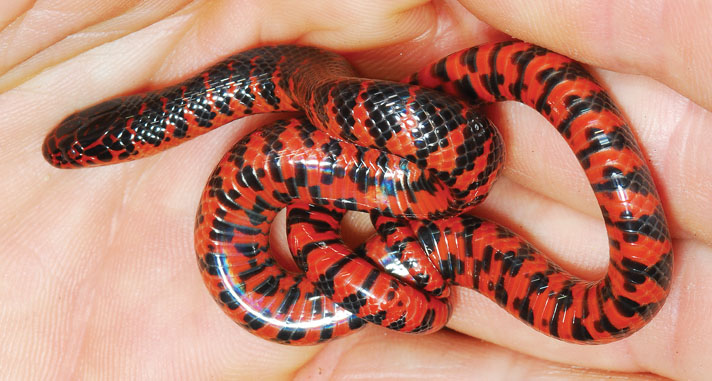
bill love
Search for mud snakes (Farancia abacura) along the canals off Alligator Alley in Florida. The red coloration serves as a warning, used to trick predators into leaving this harmless species alone.
Large-scale agriculture of citrus, vegetables and sugar cane dominates much of the inland realms of lower Florida. Abundant food ends up on the ground, and canals of all widths border most ag fields to keep the water drained during the rainy times and irrigated when it’s dry. It’s the perfect combination to spawn rodents that also burrow into the ditch banks for shelter in places that are not disturbed by pickers and the movement of big equipment. These waterways become densely overgrown with vegetation and provide ideal corridors for rodent-eating snakes that are prowling for a feast.
There’s a problem with wandering into ag lands to seek snakes, though. Farmers don’t want herpers in there, and most of the good old places are now fenced off. Their reasons are valid — liability worries if you get hurt, fear of disturbing or theft of property, the spread of crop diseases, etc. Plus, farmers may also desire to encourage snakes that eat ag pests to remain on their lands, and they don’t want them being bothered. This is why it’s essential to secure permission to enter such places before trespassing.
Having lived and herped in Florida for four decades, I need to mention one more fave area before I overdo it on any one state. Give the Florida panhandle a look — specifically the Apalachicola National Forest that spans Franklin and Liberty counties. A network of unpaved roads crisscrosses this huge tract of relatively unspoiled land, allowing access to within about five miles of nearly all of it. The roads themselves can be driven all day without repeating any, giving you a taste of diverse habitats while keeping your eyes peeled for whatever living herps might be spotted. Tracks in the sand can also be seen fairly easily, leading to further exploration on foot to find the creatures that left them as a tantalizing clue.
Herping The Midwest
Heading northward, the bluffs along the mighty Mississippi River are havens and hibernacula for a rich array of snakes north of approximately St. Louis, especially during a couple weeks when mass emergences and returns take place. Snakes are creatures of habit that seek their favorite denning places and can be observed in numbers when the mass migrations occur in the weeks surrounding mid-April in spring and again in late September in the fall. Many of the popular spots are now protected from exploitation to protect the snakes when they’re vulnerable while on the move. Visiting to simply walk, observe, and photograph, however, is fine and even encouraged.
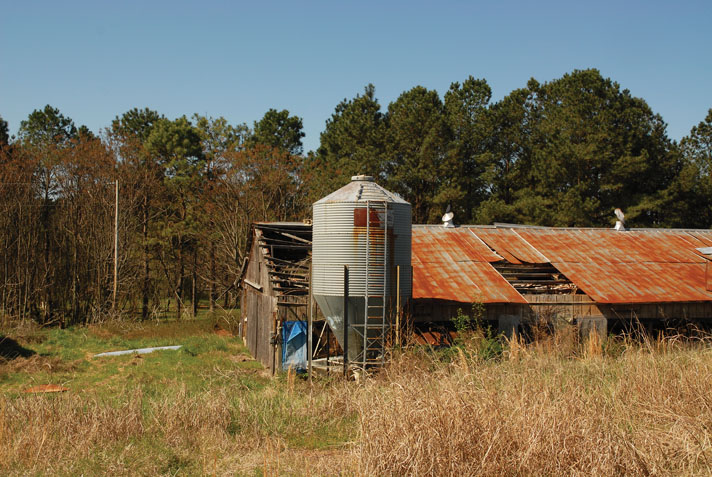
bill love
Old, abandoned structures usually sit on land with boards and tin laying around, and sometimes rat snakes are in the roofs. Always get permission before exploring such places on private property.
The fertile floodplains between the cliffs and the river are heavily used for agriculture, but it’s also where the snakes head for the summer. They are more scattered then, and require a little more work to find, but seeking them out along field edges and under debris can yield amazing results during the warmer months. As usual, be sure to obtain permission to enter private land beforehand because those fields’ owners have the same concerns as the folks down in Florida.
Rock-strewn hillsides in eastern Kansas have been a herping mecca for me on hot sunny days while flipping semi-embedded rocks to reveal hidden speckled (Lampropeltis getula holbrooki) and prairie (L. calligaster) kingsnakes and “collies” (collared lizards, Crotaphytus collaris) in rapid-fire succession. Grasslands, despite their blasé looks, harbor a rich assortment of species because grasses provide superb grazing for rodents. The hills I herped didn’t look like ideal snake habitat, but they surprised me with the abundance of encounters they’ve yielded.
Are There Reptiles In New Jersey?
Another “up north” region where you can spend endless hours exploring for herps is the Pine Barrens of southern New Jersey. This vast area of pine forest and marshes is accessible by many sandy tracks. Some lead to long-forgotten structures, abandoned agricultural plots or hidden dump sites that offer shelter to herps. Other paths take you to bogs, ponds and streams that would never be suspected of existing if you never strayed from the paved highways. Most of these roads are drivable with a normal car, but bring a winch in case you get stuck.
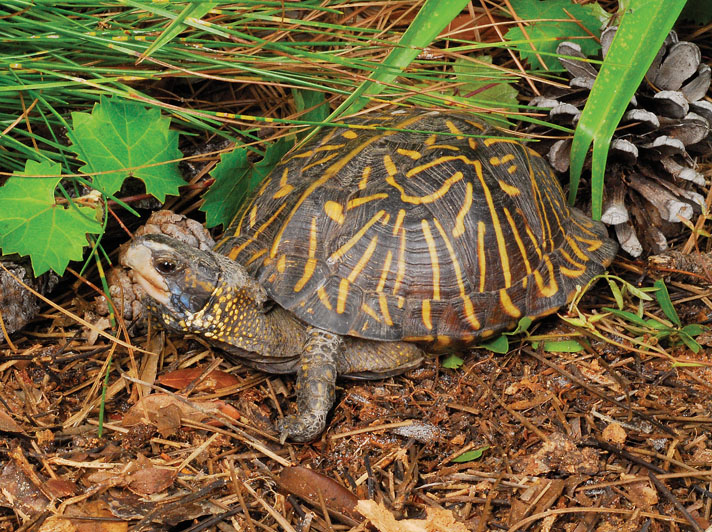
bill love
Warm summer rains bring box turtles (Terrapene) onto roads, where they may resemble stones on the blacktop.
The prize to see in the Barrens is the big northern pine snake (Pituophis melanoleucus), a day-active species that can exceed 6 feet in length. Eastern chain kingsnakes (Lampropeltis getula) reach the northern limits of their range here, and black rat snakes (Pantherophis obsoletus) and timber rattlesnakes (Crotalus horridus) can also be found in isolated areas.
Eastern box turtles (Terrapene carolina) are frequent “lumps in the roads” that are always a delight to come upon. Follow them as they cross and maybe you’ll be lucky enough to witness them finding a patch of black- or blueberries to gorge upon. Delicate Pine Barrens treefrogs (Hyla andersoni) and other anuran species can be seen and heard calling from standing water after summer downpours.
Reptiles And Amphibians Of Texas
There are oodles of great places to herp in Texas, but there are two regions I consider standouts: the mesquite prairies of the southern “arm” of the state, and the huge Trans-Pecos covering a sizable area from about the town of Del Rio on the Rio Grande River across to Big Bend National Park and beyond.
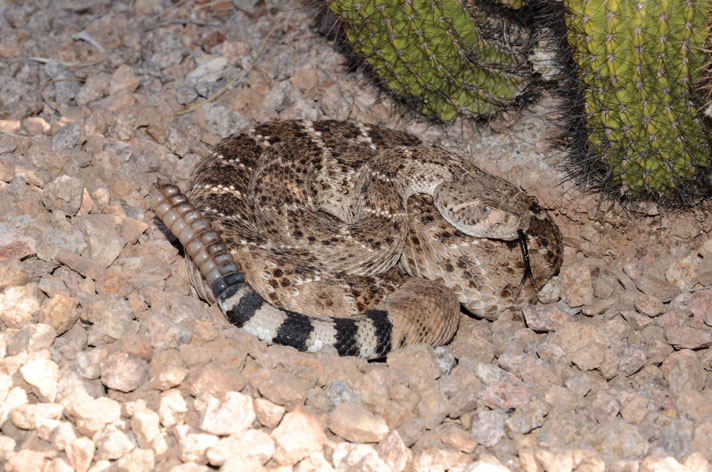
bill love
The rattlesnake most commonly encountered has got to be the western diamondback (Crotalus atrox). Use a long lens to photograph this magnificent but dangerous herp from at least 10 feet away.
Both of these areas that hug Mexico have a huge diversity of species. For sheer numbers of snake encounters on roads at night, I’d say the southern area between San Antonio and Brownsville offers the best road-cruising. Western diamondback rattlesnakes (Crotalus atrox) will comprise about 90 percent of the serpents you will find crossing the roads, but if you put in the time, you may be rewarded with sightings of Mexican and Big Bend milk snakes (Lampropeltis triangulum), Emory’s rat snakes (Pantherophis emoryi), bull snakes (Pituophis melanoleucus sayi), desert kingsnakes (L. getula splendida), and western hognose snakes (Heterodon nasicus). Most of the land out there is private and fenced, so securing permission to wander off the roads can be problematic, except in parks.
West of the Pecos River the countryside opens up with sparser vegetation and rocky terrain. The Baird’s rat snake (P. bairdi) begins to replace the common Texas rat snake (P. obsoletus lindheimeri) of central Texas, and rock, prairie and blacktail rattlesnakes (C. lepidus, C. viridis and C. ornatus) largely, but not entirely, replace the western diamondbacks.
One beautiful snake above all others has become synonymous with herping in this region of Texas: the gray-banded kingsnake (L. alterna). Searching for it at night along ridges where layers of rock are exposed has been the tried-and-true method of finding this species for decades. The easiest places to hunt for it are where roadways cut through the hills. Be sure you have your Texas hunting license on you, and also wear a reflective vest if you’ll be close to roads while walking with flashlights.
Herping In Arizona
Road-cruising works well on quiet roads, but the gorgeous scenery in the deserts and mountains makes it a joy to explore on foot for maximum coverage of Arizona habitat. Little can compare to walking a rocky dry wash festooned with holes and crevices, peering into each with the aid of a small flashlight or mirror to redirect the sun. When my light lands on scales or an inquisitive tongue flicking at me from the depths, I have no doubt that the adrenalin rush I get is every bit as transfixing as any hunter’s when he sights his quarry.
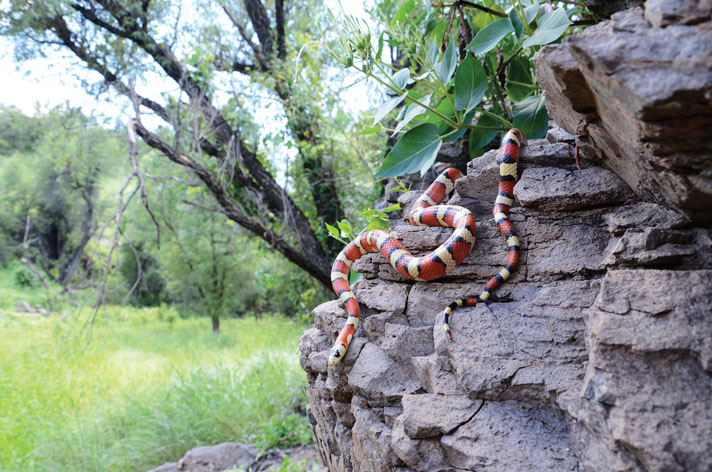
bill love
In Arizona’s Sky Islands, look for the gorgeous mountain kingsnake (Lampropeltis pyromelana) near ravines where water runs intermittently.
Two times of year are the best for herping in Arizona: April through May, and mid-July to mid-September. The spring “window” is good for herps that are out seeking mates. You’ll find a high ratio of males, but they tend to be the bigger, prettier specimens, and that’s good if you’re planning to take photos. April through May is also the absolute best time to find Arizona’s iconic lizard, the Gila monster (Heloderma suspectum), when it’s most active above ground.
Avoid June, which is the hottest, driest, most miserable time to be in Arizona. You can still find herps, but with more effort because they head for the — not the hills, the holes — down deep to avoid the heat. If you’re herping Arizona in June, plan on doing so at night, sometimes after midnight when it’s cooled down enough for herps to be on the move.
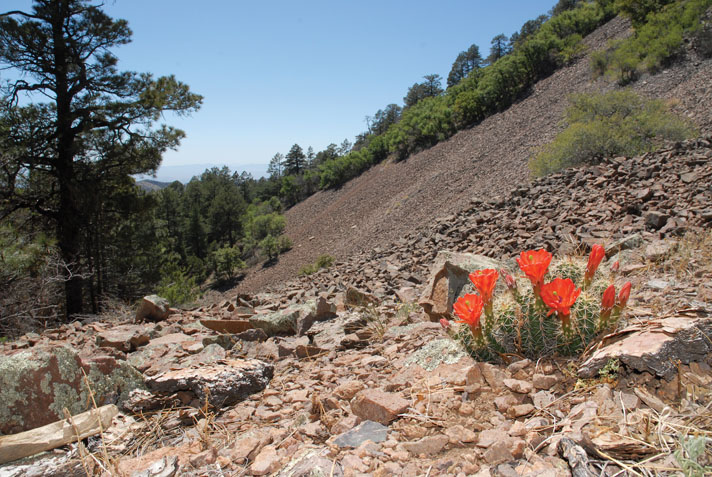
bill love
Arizona’s “Sky Islands” are mountain ranges with forests on top that are home to rarer herps that are adapted to life there, between the deserts.
Also, being in the desert during the first few downpours of the year (monsoon season begins in mid-July) can result in phenomenal herping. There are few sights more astounding than the gathering of gazillions of amphibians in flooded low spots and road swales, when everything from jewel-beautiful Sonoran green toads (Anaxyrus retiformis) to fist-sized desert toads (Incilius varius) are jostling to take advantage of the rain.
One of my greatest joys in Arizona (where I live), as well as much of the rest of the southwest, is seeing the variation across some species in each “island” of mountains. The mountain kingsnake (Lampropeltis pyromelana) follows this trend to some degree, but the speckled rattlesnake (Crotalus mitchellii) is the champ when it comes to variations from range to range. Just from their northern extreme near Las Vegas, Nev., to the Mexican border near Yuma, Ariz., you can find speckled rattlesnakes exhibiting colors that are predominately red, orange, pink, tan, light blue, gray and white. It’s fascinating to walk along stony hillsides, studying the terrain, and finally coming upon one in plain view as it mimics the color and pattern of the rock, leaving it virtually invisible.
Reptiles And Amphibians In California
There’s such a huge diversity of habitats across this one state, but my favorite places to go herping in California are in the low, dry desert and cooler montane areas.
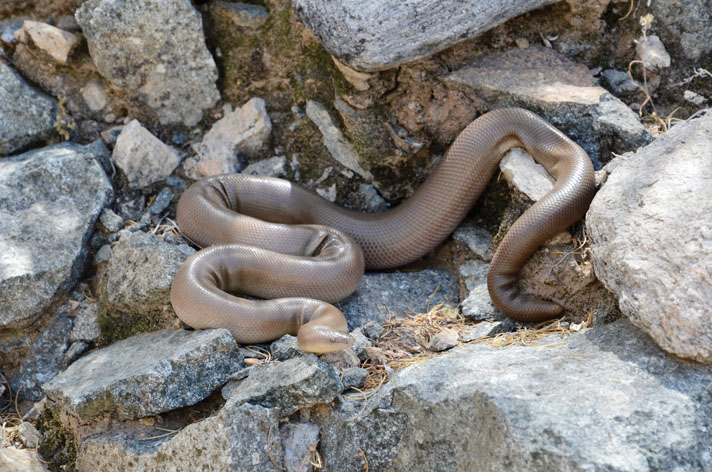
bill love
A charming little find in the northwest and mountainous parts of California is the petite rubber boa (Charina bottae). It is most active at night, even in cool temperatures when most snakes are not moving.
One night in early October, while driving through Anza-Borrego Desert State Park in southern California, rates as one of the most herp-intense, five-hour periods of my life. I must have about wore out a set of brakes due to stopping for so many “exotic” (I was living in Florida at the time) snakes and lizards that were gracing the pavement after dark.
Newborn sidewinder rattlesnakes (Crotalus cerastes) top the list of snake sightings that night; I saw more than two dozen coiled on the road, looking like white silver dollars while warming their bellies. Red diamond rattlers (C. ruber) were abundant, too (I saw nine), and juvenile glossy (Arizona elegans) and gopher (Pituophis catenifer) snakes fell somewhere in between, numbers-wise. But what I saw most were banded geckos (Coleonyx variegatus); there must have been one every 1,000 feet along County Road S-2 that winds through the park!
Although technically desert, the palm canyons near the city of Palm Springs are lush ribbons of boulders and foliage offering a retreat from the heat for plenty of herps. Trails allow easy access to some, so be prepared to encounter plenty of tourists, too. Don’t despair about that, though, as their presence has resulted in normally shy lizards, such as the chuckwalla (Sauromelas ater) and banded rock lizard (Petrosaurus mearnsi), both of which usually dive into under rocks, becoming accustomed to the presence of humans and not being as prone to flee.
During the day, California treefrogs (Hyla cadaverina) may be seen sleeping in rock crevices near a flowing stream. When I saw them, they blended in so well, looking like bumps on the rocks, that it took some careful eyeballing for irregularities to spot them.
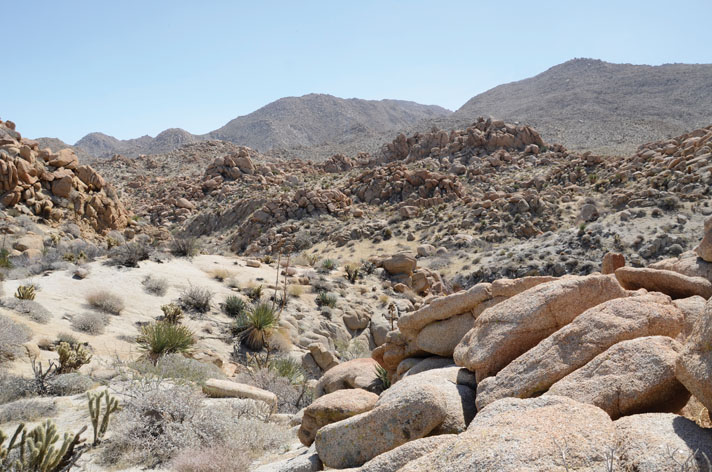
bill love
Lizards love habitat like this boulder-strewn desert east of San Diego, Calif. They dive into crevices quickly, so be ready to snap photos the moment you first spot them.
The pine forests at higher elevations in the Santa Cruz Mountains and Sierra Nevada will take you into a whole other herping world, where species that have adapted to the cooler temperatures can be found on the crawl during nights when the mercury dips into the low 60s during the summer. I was amazed that snakes were active in what seemed to me to be too-cool temps.
By day, species such as the California mountain kingsnake (Lampropeltis zonata) and rubber boa (Charina bottae) could be discovered beneath rocks in the sun, and alligator lizards (Elgaria coerulea) had adapted to hiding under the trash people had left behind.
The U.S. has so much to offer to the field-herping enthusiast. I grew up herping everywhere I could possibly give it a try. The places I’ve shared here are very general — I obey the previously mentioned etiquette of not getting too specific about my herping places — but they will hopefully pique your curiosity while steering you in a direction that leads you to discover many hotspots on your own.
Bill Love photographs herps in nature, writes and lectures. He assists his wife, Kathy, with her business, CornUtopia, and via his company, Blue Chameleon Ventures, lectures to herp groups and photographs private collections.

